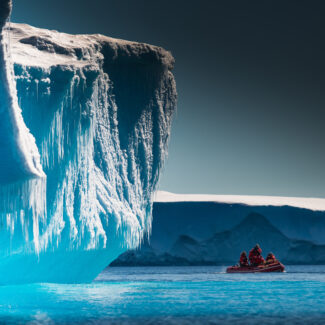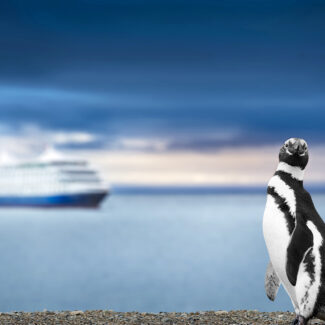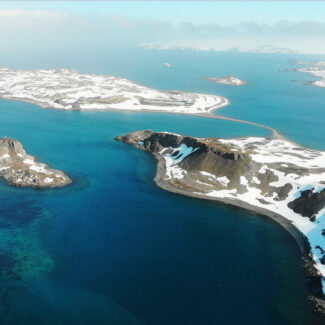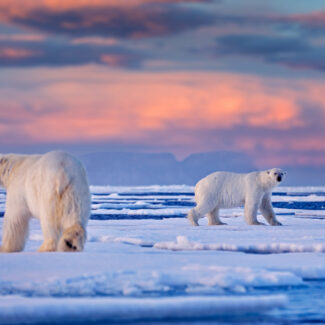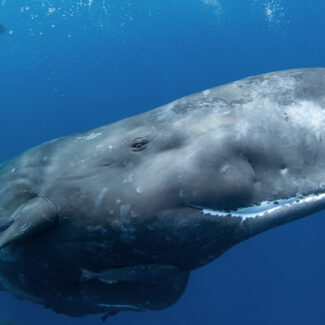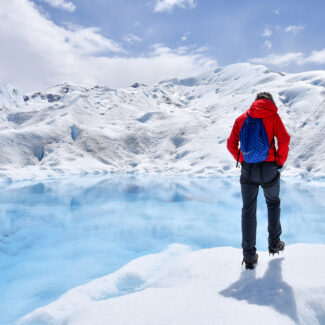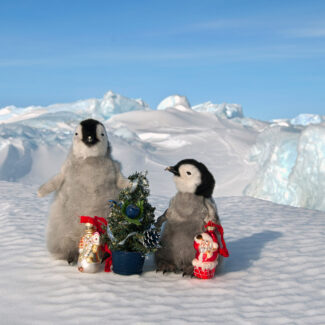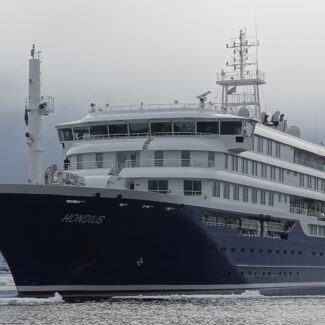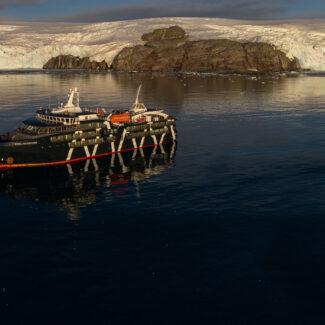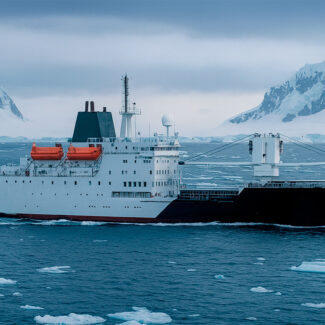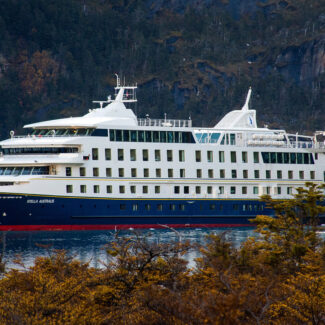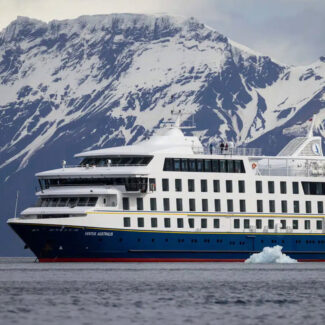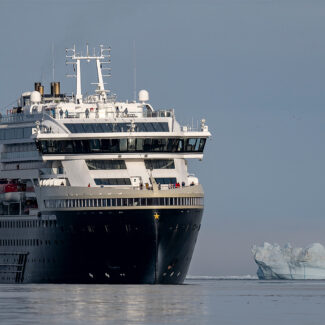The 5 Best Places To See Polar Bears In The Wild
Polar bears are not only one of the mightiest of all carnivores, but one of (relatively speaking) the most rarely seen: inhabiting as they do a Far North environment dominated by sea ice, snow, and wind-scoured tundra and mountains.
Cruises to the Arctic, however, can absolutely yield sightings of this spectacular “ice bear,” among the undisputed kings (along with the orca, Greenland shark, and Arctic wolf) of this austere and beautiful biome’s food web.
From the North Slope of Alaska to a ravishingly gorgeous, wildlife-packed archipelago under Norway’s control, here are some of the top contenders for the best place to see polar bears in the wild!
Journeying through the stark beauty of their icy realm, these polar bears embody the spirit of survival against a breathtaking Arctic backdrop. What incredible resilience!
The Best Place to See Polar Bears
We’ve chosen the following regions, which range from fairly localized areas to sprawling but unified geographies, based on the layout of the 20 defined populations into which scientists divide the global stock of polar bears, and on various other factors—from the phenological patterns of the bears themselves to accessibility and relative establishment of ecotourism. Numerous expedition cruises reach these bear-roamed corners of the Arctic, which offer incredible opportunities to glimpse one of the animal kingdom’s most magnificent representatives in the wild.
1. Churchill, Manitoba
Set on the shores of Hudson Bay, the small town of Churchill—“the Polar Bear Capital of the World”—is certainly among the best places to see polar bears, partly on account of how well-developed the bear-oriented tourism industry is, and likely the single most celebrated. Here, the Western Hudson Bay population of polar bears—which, as Polar Bears International notes, is probably the most intensively studied stock of ice bears anywhere—comes ashore every summer and early fall when sea ice retreats from the area.
This is part of the so-called Seasonal Ice Ecoregion of polar-bear range, a realm stretching between central Canada and western Greenland where sea ice greatly diminishes or entirely disappears in summertime. Polar bears in this ecoregion therefore endure a prolonged fasting period on dry land before the expansion of sea ice in mid- and late fall allows them once again to go roaming and hunting in the frozen offshore wilderness.
The hamlet of Churchill provides excellent viewing of polar bears during this onshore fasting period, especially in the early stretch of fall when the bears—except for pregnant females—mass along the tundra bayshore in anticipation of the sea ice’s return. It’s not uncommon to see male polar bears engaging in mostly low-key sparring during this window of time.
Churchill-area viewing most iconically goes down in the specialized vehicles called tundra buggies, but there are also boat and helicopter bear-watching tours. Churchill famously hosts a “Polar Bear Jail” where bears (and it’s usually adolescents) that get in trouble in town are temporarily held.
Pregnant polar-bear sows in the Churchill area don’t go back out on the sea ice in the fall; instead, they enter long-used dens in the peatland—usually in late October or early November—and bring forth their tiny, helpless cubs in those winter havens around the turn of the year. Their mother’s rich, fatty milk results in the cubs’ rapid growth, such that they can trundle along—and stay warm—upon emergence in late February or March. Mom, needless to say, is famished at that point, having endured a long stretch—sometimes as many as eight months—of basically not eating.
Worrisome trends—including an extended and ongoing decline in numbers as well as reductions in body size—suggest the Western Hudson Bay population of polar bears is among the most imperiled by climate change, as a lengthening ice-free season may be taxing the bears’ abilities to withstand the associated fasting period—not least those pregnant mother bears, who are expending much energy and nutrition nourishing their cubs while mostly not eating themselves.
Witness the incredible agility of this Arctic king as it navigates the melting ice – a powerful reminder of the resilience and challenges faced by wildlife in our changing world.
2. Svalbard, Norway
More than a few regard the Norwegian Arctic archipelago of Svalbard (formerly called Spitsbergen, a name retained for its biggest island) as the single best place in the world to see polar bears. The great carnivores are a year-round presence in the archipelago, though a goodly chunk of the resident bears—the “pelagic” portion—choose to drift away on retreating sea ice in the summer (when, in the seasonal pattern of the Divergent Sea Ice Ecoregion, a channel of open water forms along the coastline); others—some 300 or so “coastal” bears—stick around among the islands, stalking ringed seals on land-linked fast ice and along glacial fjords. (Polar bears on Svalbard have also been documented preying on reindeer, one of the few terrestrial sources of meat this primarily marine carnivore consumes.)
The Svalbard bears are part of the Barents Sea population, for which the archipelago is, along with Russia’s Franz Josef Land, the most important denning habitat; indeed, it’s one of the densest concentrations of polar-bear dens on Earth. Given how rapidly Svalbard’s warming under the effects of climate change, biologists are keenly interested in how denning patterns may be affected, including whether a greater and longer seasonal retreat of sea ice may keep some pregnant females from returning here to give birth.
From its spectacular fjords and sea cliffs to the throngs of whales, walruses, and other creatures that congregate here in the productive polar summer, Svalbard is a downright incredible place to look for polar bears—something you can very much do on our unforgettable cruises to Norway’s world-famous Arctic archipelago!
3. East Greenland
The stunning polar tableau of East Greenland, with its fortressed fjords, high-standing peaks, and sprawling glacial ice, is one of Earth’s last great wildernesses, and another of the very best places to see polar bears. Here you’ll find the biggest national park in the world: the 972,000-square-kilometer Northeast Greenland National Park, devoid of roads, commercial airstrips, and almost any other kind of development, and a globally precious refuge for the ice bear.
Indeed, this region, along with the parts of the Canadian High Arctic, falls within the Convergent Sea Ice Ecoregion, where exceptionally old and thick sea ice might end up serving as the final redoubt for the polar bear as climate change works its effects over the Arctic.
Best toured by cruise, Northeast Greenland National Park—some 80 percent of which is blanketed in the mighty Greenland Ice Sheet—can serve up polar-bear sightings just about anywhere along the coast, but Dove Bay and King Oscar Fjord are considered particularly fruitful locations. (The solid chance to see walrus, narwhals, reindeer, Arctic wolves, muskoxen, and other charismatic wildlife is all the more incentive…)
Look at these bundles of fluff! Even mealtime is a playful lesson for these polar bear cubs as they learn essential skills under the watchful eye of their devoted mother.
4. Canadian Arctic Archipelago
Canada harbors anywhere from one-half to two-thirds of all the polar bears in the world, and the country hosts the greatest number of distinct polar-bear populations. While the status and projected trajectory of these stocks varies greatly, the far northern reaches of the Canadian Arctic Archipelago—the most extensive swath of land north of the Arctic Circle in the world—definitely composes part of what many scientists believe represents the most secure long-term habitat for the species in light of climate change, along with northern and eastern Greenland. This realm has been termed the “Last Ice Area,” in reference to it being potentially the ultimate holdout of sea ice under present climatic-warming trends.
Cruises to the Canadian High Arctic, therefore, give you not only the chance—always lowish-odds, but certainly there—to spy one of the great ice bears, but also reflect upon the preciousness of this top-of-the-world environment as an all-around polar sanctuary.
5. Kaktovik, Alaska
Barter Island off the North Slope coast is very likely the best place to see polar bears in Alaska. It’s right in the heart of the Southern Beaufort Sea population, for one thing, and also legal Native subsistence hunting of bowhead whales by the island’s Inupiat people produces carrion that draws in the bears.
Such a predictable food source is understandably hard to resist for such an opportunist carnivore, and concentrates the bears in a relatively accessible area, offering remarkable photographic and observational possibilities, albeit a less ‘natural’ one than a chance bear encounter. Still, it’s a fascinating example of how human activity, when conducted sustainably and respectfully, can inadvertently create spectacular polar bear encounters, and provide a raw and authentic glimpse into the Arctic ecosystem and the delicate balance that exists between its cohabiting species.
Disclaimer
Our travel guides are for informational purposes only. While we aim to provide accurate and up-to-date information, Antarctica Cruises makes no representations as to the accuracy or completeness of any information in our guides or found by following any link on this site.
Antarctica Cruises cannot and will not accept responsibility for any omissions or inaccuracies, or for any consequences arising therefrom, including any losses, injuries, or damages resulting from the display or use of this information.



